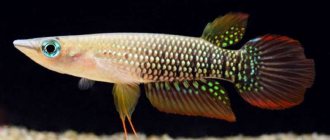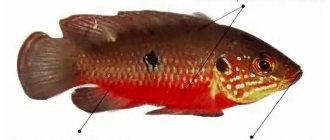author: fisher 02/11/2017 0 Comments
Family: Cyprinidae
other fish
The cardinal (Tanichthys albonubes, Lin, 1932) is a compact four-centimeter fish of the carp family (Cyprinidae) - one of the most common aquarium fish. The first specimens of cardinals were discovered and caught by Chinese boy scout leader Tang Kang Fei in the White Cloud Mountains, a few kilometers away north of the city of Guangzhou. This is where the species name of the fish comes from - albonubes (alba nubes, which means white clouds in Latin). And the name of the genus was given by the director of the Canton Ichthyological Station, Lin Shuen, who was the first to describe the species, in honor of its discoverer.
Cardinal - veil form
Already in 1932, the first specimens of cardinals were brought to the USA, and soon spread to other countries, including Germany. After appearing in European aquariums, cardinals immediately won an army of fans, thanks to their peacefulness, compactness, amazing decorativeness, and ease of maintenance. In addition, they can be bred even in relatively cool water. At first, cardinals were often compared to neons, calling them “poor man's neons,” since blue neons were still rare and too expensive at that time, and cardinals were relatively cheap.
Even now, almost a century later, cardinals , along with zebrafish, guppies and swordtails, are the first to appear in the aquariums of most beginning hobbyists.
Habitat of the cardinal in nature
Representatives of this breed belong to the carp family, the ray-finned class. And they received their “high-ranking” name from the light hand of traders, who in this way hoped to increase sales of this commercial fish.
And if we consider the classic name of the species - “alba nubes”, then from Latin it is translated as “white clouds” - very romantic and airy. In their homeland they are called “Guangdong minnow” or “white cloud mountain minnow.”
For the first time, fish were discovered in reservoirs in China. They were described and studied by Tan Meng Yo, and this happened in 1930. He described cardinals as unpretentious inhabitants that can thrive in cool water. And later it turned out that they take root well in an aquarium.
Later, these fish could be found on sale under a variety of names. They were called cardinals, Chinese danios, false neons, magnificent minnows.
Due to changes in the natural conditions in which the cardinal is accustomed to living, the number of the breed has decreased significantly. People began to settle in wild places; more often, nature is replaced by artificial parks, hotels, and resort sanatoriums. This led to the almost complete disappearance of fish of this breed, and since the 80s of the last century there has been no information about cardinal populations.
Chinese and Vietnamese zoologists have already classified this breed as an extinct species. However, few alba nubes have been found in isolated areas of Gaung Dong province, water bodies on the Chinese island of Hanyang and Vietnam's Quang Ninh province.
But although populations have been discovered, cardinals are still considered a rare, endangered breed in their homeland of China. The government of the country has taken a number of measures to restore the species in the natural environment. And all the fish that can be found on sale are the result of raising them in captivity.
Price
Cardinals are widely available for sale. The cost of aquarium fish depends on the size, breeding form and pricing policy of the seller.
| Size 1-3 cm | Average cost, in rubles |
| Cardinal | 45-55 |
| Golden cardinal | 50-60 |
| Veiled cardinal | 100 |
| Albino | 75 |
Selected morphs are less commonly found on sale and are often available only to order.
Description of the cardinal fish
Individuals of this species are small fish with bright colors. Their size does not exceed 4 cm, and males have a slimmer body and an intense color of scales. Cardinals cannot be called long-livers, which, in fact, applies to other small inhabitants of aquariums; their life expectancy is a year and a half. In nature, they live in the upper and middle water layers; they can go lower, but they rarely do so.
mouth is directed upward, which is associated with the way they feed - they pick up insects from the surface of the reservoir. The individuals have no antennae the dorsal fin is at the same level as the anal fin. The main color is brown-bronze, there is a fluorescent line that runs down the middle of the body - from the eyes to the caudal fin, where it ends in a black dot.
One part of the tail is transparent and decorated with a bright red spot. The abdomen, in comparison with other areas, is lighter; there are red spots on the anal and dorsal fin. There are several hybrid species of cardinals that are bred artificially: albino cardinal, golden cardinal, several veil varieties.
Diseases
Cardinals, like all living things, get sick. Most diseases occur due to non-compliance of living conditions with certain standards. Incorrectly selected aquarium capacity, lack of proper filtration, and aeration reduce the immunity of the fish.
All this leads to the development of the following diseases:
- Infectious, which can be caused by dirty water or undisinfected soil.
- Parasitic, caused by poor-quality food, the presence of infected individuals in the container.
- Fungal and gastrointestinal, arising due to improper nutrition.
Cardinal fish have good health, but this does not negate the necessary care. If not properly cared for, the fish will get sick.
But in addition to the usual diseases inherent in many aquarium species, cardinals sometimes suffer from a specific ailment characteristic only of this species (pictured above).
Distinctive signs of the disease are the appearance of growths on various parts of the fish’s body. Initially, the disease affects the upper lips, on which a small grayish or black tumor forms. The tumors then spread to other parts of the body.
The appearance of neoplasms does not in any way affect the vital functions of the fish, which retain their appetite and mobility. The growths are transmitted only to pets of this species. The pathology is not transmitted to individuals of another species neighboring cardinals.
The cause of the disease has not yet been established, so it is not known how it can be prevented. But the spread of most diseases can be prevented if you keep the aquarium clean and feed the fish with high-quality food.
Who do cardinals get along with?
These small fish are schooling creatures, which is how they feel most comfortable. Therefore, it is recommended to immediately start a whole family of cardinals, consisting of 15-20 pieces. If one or several individuals live in the aquarium, they lose their color, become pale and spend most of their time in hiding.
These are peace-loving inhabitants who are not capable of offending even the fry, so it is better for them to live with the same docile and non-conflict fish. You should not place large, aggressive, predatory individuals in the aquarium with cardinals, who will consider these little ones as prey.
But the following representatives get along well with these bright fish:
- microanalysis galaxy;
- guppy;
- Endler's guppies;
- Danio rerio.
You can find recommendations for keeping “alba nubes” with goldfish, which are based on the love of both species for cool water. But these large ray-finned fish are very voracious and are capable of eating small cardinals. Therefore, it is better not to consider this combination.
Kinds
Cardinals, which splash peacefully in home aquariums, have already been bred in captivity for several generations. And thanks to the efforts of breeders, Tana fish has three beautiful varieties:
- gold;
- veil;
- albino.
All varieties grow up to 3-4 cm in length and are kept in the same conditions.
Cardinal gold
The golden cardinal subpopulation is a fish with a harmonious body. Differs from the species-forming representative in yellow-orange color. Below the shining line, some specimens have a pattern of small black inclusions. Red gills contrast against the general background. The fins, excluding the pectoral ones, are ruby in color with a white edge.
The color of the golden cardinal includes shades of yellow and scarlet.
Veiled
The most beautiful selection variety. Typical differences between the morph and the standard are silver-brown color, elongated and lush fins are formed.
Veil-shaped or fan-shaped rays significantly transform individuals, but require consideration of this feature when keeping them.
The veiled cardinal has lush fins
Albino
The albino form is very different from other cardinals due to the lack of pigment in its color. This feature allows you to “dilute” a nimble flock with contrasting variety.
Aquarium maintenance of cardinals
Despite all the unpretentiousness of the fish, it is still worth providing them with everything they need and equipping the aquarium in such a way that the fish are as comfortable as possible:
- the most suitable shape of the tank is oblong;
- for 5-8 individuals, a 15-20-liter container is sufficient, but it is better to purchase a more spacious, 40-liter tank;
- the water level should not fall below 25 cm;
- cardinals do not tolerate warm water well, in such conditions their color becomes dull, as a result they live shorter;
- sharp temperature changes are also contraindicated for these fish - in this case there is a high risk of developing fungal diseases;
- the optimal water parameters for cardinals are as follows: temperature from 18 to 22°C, hardness 4-20, pH 6.5-7.5;
- As for filtration and aeration, experienced aquarists recommend not to neglect these measures;
- water changes are necessary - about 30% of the total volume - at least 2-4 times a month;
- cardinals love bright light, so it’s worth taking care of additional lighting;
- Both sand and small pebbles can be used as soil; it is desirable that the coating be dark;
- these fish prefer dense thickets, but it should be remembered that the plants should not block the access of light to the bottom and block the entire space, otherwise the inhabitants will have nowhere to swim;
- you can plant ferns, myriophyllums, elodeas, limnophils and other plants with small leaves; duckweed or riccia can be located on the surface;
- You can decorate the tank with artificial decor: a grotto, driftwood, pebbles.
Interesting Facts
- In Asia, cardinals are sometimes kept as pond fish. They are not only beautiful, but also help in the fight against mosquitoes.
- These cyprinids are able to withstand temperature changes from 14 to 30 degrees.
- The name cardinal is a commercial move. Traders gave it to these fish so that the goods could be sold better. This name was often found in German books on aquarium husbandry of that time, from where it came into Russian speech and took root.
- In China and England, the fish are called white cloud mountain minnow, or Guangdong minnow. They are named so because of their habitat. Cardinals can be found in the fast and cool water streams of Mount Baiyunshan, which is also known as White Cloud Mountain.
As we can see, caring for cardinals is really not difficult. They are loyal to the volume of the dwelling, and to the water parameters, and to the food. The only thing that is important is to keep the water clean. And so these fish will delight the owner not only at home, but even in a mini-aquarium in the office on the desktop.
ENDLER'S GUPPY CONTENTS REPRODUCTION PHOTO COMPATIBILITY DESCRIPTION VIDEO.
How and what to feed these little fish
Wild representatives of the species eat insects that find themselves on the surface of the water. The aquarium cardinal is not very picky and will eat what is given to him - live, frozen, granular food, flakes. You can feed the fish with live bloodworms, tubifex, and brine shrimp.
These fish have a small mouth that “looks” upward, so they are not very good at picking up large particles of food from the bottom.
Nutrition
Analysis of the stomachs of wild individuals showed that they feed on small insects, worms, crustaceans and other zooplankton.
Cardinal (Tanichthys albonubes) in an aquarium, feeding.
The aquarium is omnivorous, but the best conditions and coloration include a regular feeding of small live and frozen foods such as bloodworms, daphnia and brine shrimp, along with good quality dry flakes and pellets, some of which should include additional plant matter.
Differences between males and females
Cardinals do not have clear gender differences, but the owner can still quickly determine which of his pets is a “boy” and which is a “girl.” Males are smaller in size than females, but their color is more intense, attracting attention. Females have a full, rounded abdomen.
Individuals reach sexual maturity at 6-13 months. The fact that the male has reached this period can be understood by his behavior: the fish begins to “perform” in front of other male competitors, revealing its fins and demonstrating its bright colors. Such “pirouettes” attract the attention of “ladies”.
Sexual Dimorphism
Determining gender is not so easy. Generally, the male is brighter in color with a more slender body than the female. The dorsal and anal fins of the male are wide and fan-shaped, while those of the female are triangular and wedge-shaped.
Veiled cardinal (Tanichthys albonubes) male and female, pair, difference.
During the spawning period, the female's abdomen becomes fuller and rounder.
Reproduction and breeding
Cardinals are unpretentious and easy to keep and breed. They spawn and are able to spawn all year round. There are two options for breeding these fish:
- When keeping a flock of cardinals in one tank, you can let everything take its course and expect offspring. These fish are not prone to cannibalism, they don’t even touch the eggs, so after a couple of months the aquarium will be full of growing individuals.
- The second option is to install a small (20-40 liter) spawning tank. You should put a couple of males into it, choosing the brightest colored ones, and 4-5 females. It is necessary to place vegetation in the container on the leaves of which cardinals lay eggs.
It is worth taking care of suitable water parameters - softness pH 6.5-7.5 and temperature from 18 to 22°C. There is no need to cover the bottom with soil in the spawning tank, but a little filtration and a weak current will be useful. It doesn’t matter whether the fish spawn in a community aquarium or separately, they must eat well - plenty of high-quality live food. Suitable meat is shrimp, daphnia, and tubifex. If there are no live rations, you can give frozen ones.
When the female lays eggs on the leaves of the plants, the parents can be returned to the common tank. After one and a half to two days, the fry will be born, they are fed with small starter feeds - rotifers, live dust, crushed egg yolks. Even the tiny cardinal is quite tenacious - it is very easy to feed the babies, especially since they grow quite quickly.
The cardinal is a small, nimble fish that does not require complex care. And if a novice aquarist gets such nice pets, then he does not have to face disappointments and failures. These inhabitants of the underwater world are distinguished by their liveliness, mobility and good disposition - an ideal combination for a mini-aquarium community.
Reviews
Aquarium fish cardinals, despite their small size, will decorate the aquarium and bring the owner many positive emotions.
Have you kept cardinals in an aquarium? Or maybe you’re just getting ready? Share your impressions of these amazing fish.
Photos of cardinals
Compatibility
It is ideal to keep a school of Tanichthys alboneubes in a separate aquarium. Pets will feel more comfortable without the presence of neighbors. The fact is that cardinals are non-conflict and peace-loving in nature. They may be offended by a more aggressive breed:
- Astronotus;
- Piranha;
- Barbus;
- Gold fish;
- Angelfish.
Large fish can take away food and space from cardinals. This will affect the external and physical characteristics of Tanichthys alboneubes. If an aquarium owner wants variety among underwater pets, then you should pay attention to:
- Guppy;
- Fire tetra;
- Danio;
- Ternetia;
- Neon;
- Rhodostomus;
- Gourami;
- Shrimps;
- Corridor.
Guppy
Fire tetra
Danio
Ternetia
Neon
Rhodostomus
Gourami
Corridoras
Death
By the autumn of 1642, Richelieu's health had deteriorated sharply. Neither healing waters nor bloodletting helped. The man regularly lost consciousness. Doctors diagnosed purulent pleurisy. He tried his best to continue working, but his strength was leaving him. On December 2, the dying Richelieu was visited by Louis XIII himself. In a conversation with the king, the cardinal announced a successor - he became Cardinal Mazarin. He was also visited by envoys from Anne of Austria and Gaston of Orleans.
Cardinal Richelieu on his deathbed
His niece, the Duchess de Aiguillon, did not leave his side in recent days. He admitted that he loved her more than anyone in the world, but he didn’t want to die in her arms. Therefore, he asked the girl to leave the room. Her place was taken by Father Leon, who confirmed the death of the cardinal. Richelieu died on December 5, 1642 in Paris; he was buried in a church on the territory of the Sorbonne.
On December 5, 1793, people burst into the tomb, destroyed Richelieu’s tomb in a matter of minutes, and tore the embalmed body to pieces. The boys on the street were playing with the mummified head of the cardinal, someone tore off a finger with a ring, and someone stole the death mask. In the end, these are the three things that remain from the great reformer. By order of Napoleon III, on December 15, 1866, the remains were solemnly reburied.
Title history
The history of cardinals dates back to the first century AD. e. - to the seven ancient deacons chosen by the apostles and appointed to care for poor Christians (Acts -6). Under the Roman bishop, the tradition of electing seven privileged archdeacons was maintained for a long time, who soon concentrated in their hands enormous financial, administrative and even spiritual power, since they reported directly to the pope. Moreover, the popes themselves often depended on their closest and powerful subordinates - the papal archdeacons - who began to be respectfully called cardinals. The papal archdeacons did not lose the title of cardinal even when they were promoted, ordained presbyters and, further, bishops. Over time, all cardinals began to be ordained bishops, but at the same time they receive a double (parallel) spiritual rank. That is, those Catholic bishops who bear the title of cardinal, no matter in what part of the world they head their dioceses, are necessarily assigned to one of the parish churches of the city of Rome as a simple priest or even a deacon.
In the east of the Roman Empire under Emperor Theodosius I the Great the word Cardinalis
occurs as the name of an official.
From the 5th to the 11th centuries, this was the name given to clergy who occupied permanent positions at certain city parish churches, who were firmly connected to their places, “like a door is connected to the hook on which it hangs.” While in other places the title "cardinal" lost its meaning and disappeared from use, in Rome it became increasingly important. Rome was divided into seven districts (“a city on seven hills”), each of which had its own main church - Titulus
- and its abbot was called
incardinatus
,
cardinalis
. These churches were parish churches in the proper sense - only the sacred church sacraments were taught in them. Cardinal-priests and cardinal-deacons of Rome were present in the council of the pope and took a significant part in his election, when the choice depended on the clergy and people, but were also considered (as can be seen from the acts) below any bishop. There were no cardinal bishops then, but the bishops of the Roman metropolis, of course, took part in both the council and the selection of the pope.
Editorial: Ctenopoma leopardum
Cardinal's coat of arms
It was only from the 11th century that these suburban bishops: Ostia (now Ostia and Velletri), Porto, Santa Rufina (later united with Porto), Albano, Sabina, Tusculum and Palestrina (Preneste) were called cardinals
Of great importance in the history of the development of the cardinalate is the decree of Pope Nicholas II issued at the Lateran Council (1059), by virtue of which the College of Cardinals received the right to choose the pope. This decree remains in force to this day.
Under Innocent IV, the cardinals received a status above all bishops and a red cap, symbolically meaning that until the last drop of blood, without fear of death, they would act “pro exaltatione sanctae fidei, pace et quiete populi christiani, augmento et statu Sanctae Romanae Ecclesiae” (“ for the sake of the exaltation of the holy faith, peace and tranquility in Christian nations, the growth and strength of the Holy Roman Church").
- Boniface VIII gave them the princely mantle;
- Paul II - the right to have a white horse with a red blanket and golden reins;
- Pius V in 1567 prohibited those who had not received this rank from the pope from being called cardinals;
- And under Urban VIII (1630), the cardinals received the title of lat. "Eminentissimus", "Eminentia", "His Eminence", worn by the ecclesiastical electors.











